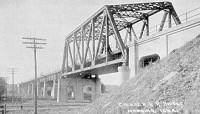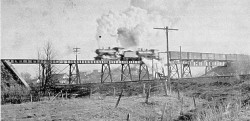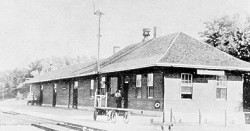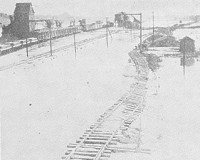
RAILROADS

The coming of railroads to Carroll County had been eagerly sought by the early settlers for many years. In the 1850s, when the county was organized, the State of Iowa had already obtained a land grant of some 88,000 acres for the right-of-way for a transcontinental railroad. However, the Civil War intervened and forced postponement of construction for a number of years. After the war, the Chicago and Northwestern was advanced across the state, reaching Council Bluffs in 1867.
Even after construction of the transcontinental line, some parts of the county were still remote from the railroad and development was retarded. With this in mind, the Northwestern was induced to construct the Iowa Southwestern in 1880 with the objective to reach Harlan. The yards and depot were constructed at Manning in the summer of 1881 just west of Main and First Streets. The first trains were run in the same year, with common box cars having seats nailed in and windows cut out of the sides for passenger service.
In 1881 the Chicago, Milwaukee and St. Paul Railroad was also constructing a road across Iowa, south of and parallel to the Northwestern. After several surveys and due to rough terrain
Continued from page 9

further south, the Milwaukee Road was finally established across the southern townships of Carroll County and crossed the Southwestern at what is now the site of Manning. At first the Milwaukee objected to erecting a depot in Manning due to the rough topography of the country, as the road bed would have to be raised and the depot would be on a curve. Another objection was that the company owned no other land than their right of way, and would have to buy land for the depot and yards from various individuals.
To overcome these contingencies, the town of Manning appointed a committee to confer with the officials of the railroad at Marion. If possible, they were to secure the location of its depot grounds here instead of at Warrick, which was located about two miles east of Manning. The result of the interview was that the company agreed to put in a station and freight yards, providing that the town pay them a bonus of $5,000, with which to build the grounds. The town accepted this proposition and on September 5 voted a bond of $5,000.
The Milwaukee right-of-way passed through the town through what is now the city park and athletic field, with the depot located north and west of the present Legion Hall. The Milwaukee crossed the Southwestern Line and the Nishnabotna River on a 1,150 foot long trestle just west of where the Spies Fur Company is now located, and ran slightly northwest through the area where the L. R. Nelson Manufacturing plant stands.
In 1882 further railroad construction saw the branch of the Southwestern built from Manning to Audubon. This line passed through south of the Milwaukee road, just behind the present Municipal Light plant and American Legion Hall.
Further development in railroad transportation came with the construction of the Chicago Great Western Railroad from Fort Dodge to Council Bluffs in 1903. It passed southwesterly across Carroll County, paralleling the Southwesterns' Harlan branch on the west side. This depot was located on West Third Street.
This gave Manning unexcelled railroad transportation for a town this size, with lines going in five directions. For example, the June 1916 Official Guide of Railways listed the following trains through Manning: the Chicago Northwestern Railroad (formerly the Southwestern extension) scheduled three trains each way; the Chicago Great Western Railroad scheduled three trains each direction; and the Chicago Milwaukee and St. Paul Railroad had five passenger trains each way. In addition, many freight trains traveled these lines.
Due to increasing traffic, the Chicago Milwaukee Railroad in 1913-14 found it necessary to relocate their trackage across Iowa in order to eliminate many curves and grades. At this time the road was double-tracked from Chicago to Manilla. In this relocation, the Milwaukee Road was moved from the south part of town to the present location on the north edge of town, and a new depot was built. A higher, longer bridge was constructed to cross over the Nishnabotna, the Chicago North Western and Chicago Great Western railroads. Most of this work was done with teams of mules, steam shovels, and small gauge railroads.
In the depression years of the 1930s, all railroads suffered from a decline in patronage and revenue due in part to the ever-growing use of

Continued from page 10
the automobiles and paved roads. The railroad still tried to woo passengers by placing in service streamlined trains such as the Milwaukee's Midwest Hiawatha which raced through Manning at nearly 100 MPH! In spite of this, the railroads were forced to curtail the frequency of service compared to the booming years of early construction. An example of this occurred in 1937, when extensive washouts caused the Chicago Northwestern to abandon part of their line and they secured trackage rights over the paralleling Chicago Great Western from Carroll to Manning. In 1940 similar flooding closed the Manning-Harlan line and again trackage rights were obtained from the Great Western.
Although there were such innovations as the "T-Bone Special" from Audubon, declining revenues forced the Northwestern to abandon the line from Manning to Audubon in June of 1952.
There was a brief revival of passenger trains through Manning in 1955, when the Union Pacific Railroad agreed to run their Streamliners through Iowa on the Milwaukee Road.
This great yellow fleet of Streamliners roared through Manning during the night hours and the only local passenger and rail service was provided by the Arrow. At this time, although the passenger service on the Northwestern had long since vanished, the Great Western was still providing one-way each-day service between Minneapolis and Omaha with stops in Manning.
Passenger service on railroads in the United States continued to decline with greater use of planes and autos. The year 1965 saw the last runs of local passenger service on both the Great Western and Milwaukee. With the advent of Amtrak in 1971, passenger trains through Manning became a memory with exception of the American Freedom Train in 1976 and possibly an occasional Amtrak detour.
With the absorption of the Great Western by the North Western in 1968, three railroads through Manning now became two. Rail-service in Manning faces an uncertain future with the bankruptcy of the Milwaukee Road and the possibility of abandonment of the Northwestern from Carroll to Harlan.
